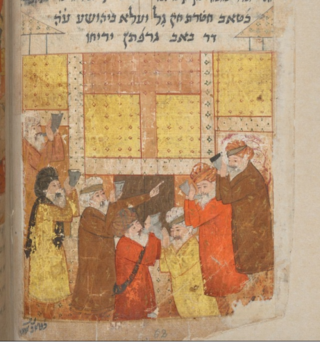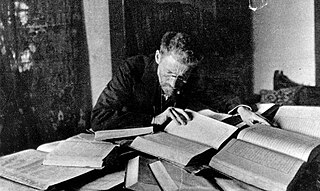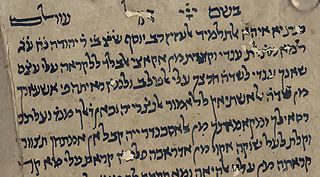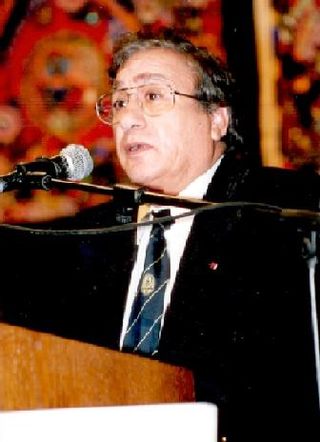
Judeo-Persian refers to both a group of Jewish dialects spoken by the Jews living in Iran and Judeo-Persian texts. As a collective term, Judeo-Persian refers to a number of Judeo-Iranian languages spoken by Jewish communities throughout the formerly extensive Persian Empire, including the Mountain and Bukharan Jewish communities.

The Haskalah, often termed as the Jewish Enlightenment, was an intellectual movement among the Jews of Central and Eastern Europe, with a certain influence on those in Western Europe and the Muslim world. It arose as a defined ideological worldview during the 1770s, and its last stage ended around 1881, with the rise of Jewish emancipation.

This is a list of articles about poetry in a single language or produced by a single nation.

Israeli literature is literature written in the State of Israel by Israelis. Most works classed as Israeli literature are written in the Hebrew language, although some Israeli authors write in Yiddish, English, Arabic and Russian.

Medieval Hebrew was a literary and liturgical language that existed between the 4th and 19th century. It was not commonly used as a spoken language, but mainly in written form by rabbis, scholars and poets. Medieval Hebrew had many features that distinguished it from older forms of Hebrew. These affected grammar, syntax, sentence structure, and also included a wide variety of new lexical items, which were either based on older forms or borrowed from other languages, especially Aramaic, Greek and Latin.
This article concerns poetry in Spain.
Rabbi Moses ben Jacob ibn Ezra, known as Ha-Sallaḥ was an Andalusi Jewish philosopher, linguist, and poet. He was born in Granada about 1055 – 1060, and died after 1138. Ibn Ezra is considered to have had great influence in the Arabic literary world. He is considered one of Spain's greatest poets and was thought to be ahead of his time in terms of his theories on the nature of poetry. One of the more revolutionary aspects of Ibn Ezra's poetry that has been debated is his definition of poetry as metaphor and how his poetry illuminates Aristotle's early ideas. The impact of Ibn Ezra's philosophical works was minor compared to his impact on poetry, but they address his concept of the relationship between God and man.
Zarphatic, or Judeo-French, is an extinct Jewish language that was spoken by the French Jews of northern France and in parts of west-central Germany, such as Mainz, Frankfurt am Main and Aix-la-Chapelle. It was also spoken by French Jews who moved to Norman England. Some have conjectured that the language influenced the development of Yiddish.

Yiddish literature encompasses all those belles-lettres written in Yiddish, the language of Ashkenazic Jewry which is related to Middle High German. The history of Yiddish, with its roots in central Europe and locus for centuries in Eastern Europe, is evident in its literature.

Hebrew literature consists of ancient, medieval, and modern writings in the Hebrew language. It is one of the primary forms of Jewish literature, though there have been cases of literature written in Hebrew by non-Jews. Hebrew literature was produced in many different parts of the world throughout the medieval and modern eras, while contemporary Hebrew literature is largely Israeli literature. In 1966, Agnon won the Nobel Prize for Literature for novels and short stories that employ a unique blend of biblical, Talmudic and modern Hebrew, making him the first Hebrew writer to receive this award.

Dan Pagis was an Israeli poet, lecturer and Holocaust survivor.

Jewish literature includes works written by Jews on Jewish themes, literary works written in Jewish languages on various themes, and literary works in any language written by Jewish writers. Ancient Jewish literature includes Biblical literature and rabbinic literature. Medieval Jewish literature includes not only rabbinic literature but also ethical literature, philosophical literature, mystical literature, various other forms of prose including history and fiction, and various forms of poetry of both religious and secular varieties. The production of Jewish literature has flowered with the modern emergence of secular Jewish culture. Modern Jewish literature has included Yiddish literature, Judeo-Tat literature, Ladino literature, Hebrew literature, and Jewish American literature.

The revival of the Hebrew language took place in Europe and Palestine toward the end of the 19th century and into the 20th century, through which the language's usage changed from purely the sacred language of Judaism to a spoken and written language used for daily life in Israel. The process began as Jews from diverse regions started arriving and establishing themselves alongside the pre-existing Jewish community in the region of Palestine in the first half of the twentieth century. Arabic-speaking Jews in Palestine and the linguistically diverse newly arrived Jews switched to Hebrew as a lingua franca, the historical linguistic common denominator of all the Jewish groups. At the same time, a parallel development in Europe changed Hebrew from primarily a sacred liturgical language into a literary language, which played a key role in the development of nationalist educational programs. Modern Hebrew was one of three official languages of Mandatory Palestine, and after the Israeli Declaration of Independence in 1948, one of two official languages of Israel, along with Modern Arabic. In July 2018, a new law made Hebrew the sole official language of the state of Israel, giving Arabic a "special status".
Modern Hebrew poetry is poetry written in the Hebrew language. Moshe Chaim Luzzatto is considered one of the earliest modern Hebrew poets.

Reuven Snir is an Israeli Jewish academic, Professor of Arabic language and literature at the University of Haifa, Dean of Humanities, and a translator of poetry between Arabic, Hebrew, and English. He is the winner of the Tchernichovsky Prize for translation (2014).

Joseph Yahalom is a professor of Hebrew literature at the Hebrew University of Jerusalem. Since 1983, he has been a member of the Academy of the Hebrew Language.

Shmuel Moreh was a professor of Arabic Language and Literature at the Hebrew University of Jerusalem and a recipient of the Israel Prize in Middle Eastern studies in 1999. In addition to having written many books and articles dealing with Arabic literature in general and Iraqi Jewish Arabic literature in particular, he has been a major contributor to Elaph, the first online daily independent journal in the Arabic language. Professor Moreh wrote in Arabic, Hebrew, and English.
The golden age of Jewish poetry in Al-Andalus developed in the literary courts of the various taifas. Like its Arabic counterpart, its production diminished in the 12th century under the rule of the Almoravids and Almohads. In the last part of the 10th century, Dunash ben Labrat revolutionized Jewish poetry in Al-Andalus by bringing Arabic meter and monorhyme into Hebrew writing. Jewish poets employed Arabic poetic themes, writing bacchic poetry, garden poetry, and love poetry.
The earliest known precursor to Hebrew, an inscription in the Paleo-Hebrew alphabet, is the Khirbet Qeiyafa Inscription, if it can be considered Hebrew at that early a stage.
Yemenite Jewish poetry, often referred to as "paraliturgical poetry" because of its religious nature, has been an integral part of Yemenite Jewish culture since time immemorial. The Jews of Yemen have preserved a well-defined singing arrangement which not only includes the very poetic creation itself, but also involves a vocal and dance performance, accompanied in certain villages outside Sana'a by drumming on an empty tin-can (tanakeh) or a copper tray. The Jews of Yemen, maintaining strict adherence to Talmudic and Maimonidean halakha, observed the gezeirah which prohibited playing musical instruments, and "instead of developing the playing of musical instruments, they perfected singing and rhythm." This arrangement was integrated into the walks of life familiar to the Jews of Yemen. The texts used in the arrangement were put down in writing and later included in separate song collections (dīwāns). The social strictures and norms in Yemenite Jewish culture provide for separate settings for men and for women, where the sexes are never mixed. Men’s song usually expressed the national aspirations of the Jewish people, and it was far removed from the singing associated with the Muslim environment, whereas folk songs of Jewish women were sung by rote memory and expressed the happiness and sorrows inherent in their daily life and was, as a rule, closer to that of Muslim women.